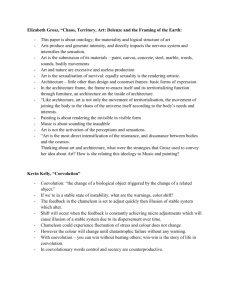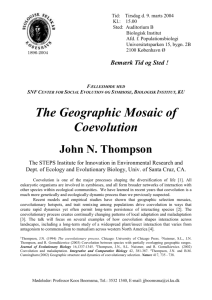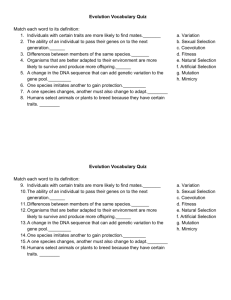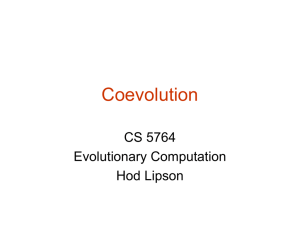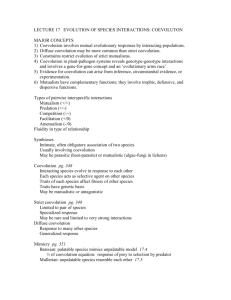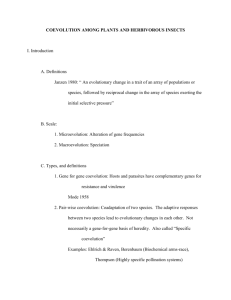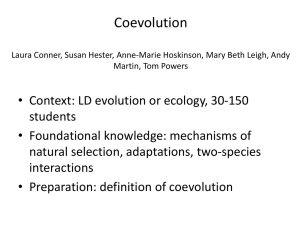Ch 15 Notes
advertisement
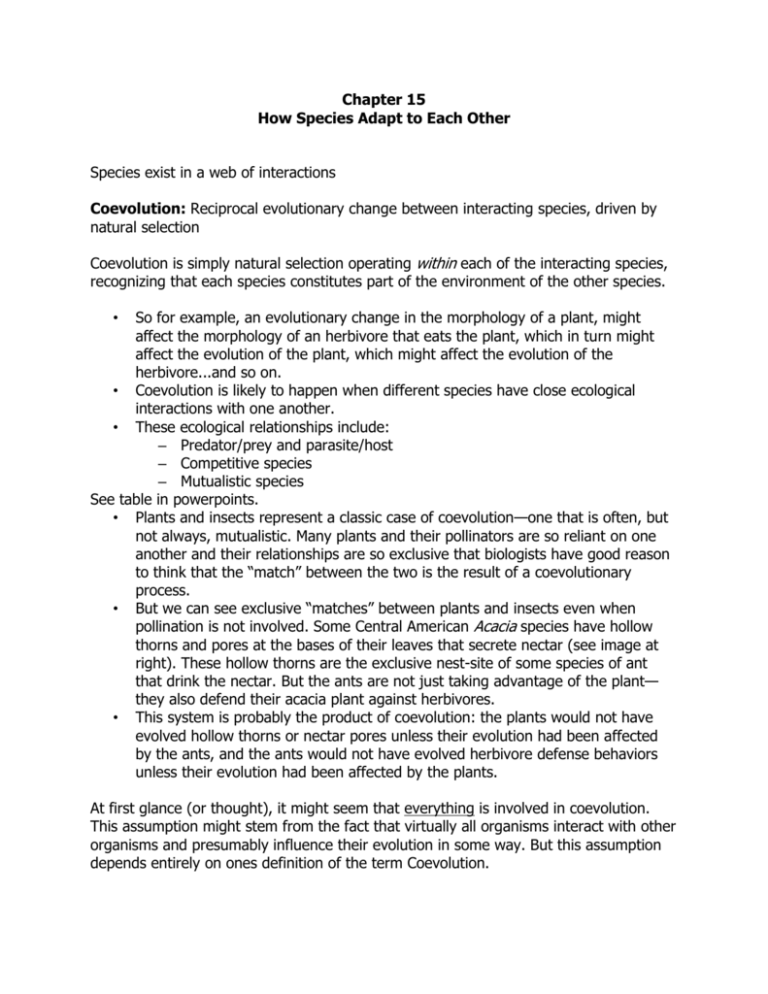
Chapter 15 How Species Adapt to Each Other Species exist in a web of interactions Coevolution: Reciprocal evolutionary change between interacting species, driven by natural selection Coevolution is simply natural selection operating within each of the interacting species, recognizing that each species constitutes part of the environment of the other species. So for example, an evolutionary change in the morphology of a plant, might affect the morphology of an herbivore that eats the plant, which in turn might affect the evolution of the plant, which might affect the evolution of the herbivore...and so on. • Coevolution is likely to happen when different species have close ecological interactions with one another. • These ecological relationships include: – Predator/prey and parasite/host – Competitive species – Mutualistic species See table in powerpoints. • Plants and insects represent a classic case of coevolution—one that is often, but not always, mutualistic. Many plants and their pollinators are so reliant on one another and their relationships are so exclusive that biologists have good reason to think that the “match” between the two is the result of a coevolutionary process. • But we can see exclusive “matches” between plants and insects even when pollination is not involved. Some Central American Acacia species have hollow thorns and pores at the bases of their leaves that secrete nectar (see image at right). These hollow thorns are the exclusive nest-site of some species of ant that drink the nectar. But the ants are not just taking advantage of the plant— they also defend their acacia plant against herbivores. • This system is probably the product of coevolution: the plants would not have evolved hollow thorns or nectar pores unless their evolution had been affected by the ants, and the ants would not have evolved herbivore defense behaviors unless their evolution had been affected by the plants. • At first glance (or thought), it might seem that everything is involved in coevolution. This assumption might stem from the fact that virtually all organisms interact with other organisms and presumably influence their evolution in some way. But this assumption depends entirely on ones definition of the term Coevolution. • • • The term is usually attributed to Ehrlich and Raven's study of butterflies on plants (1964) but the term was used by others prior to 1964 and the idea was very present in the Origin of Species. Ehrlich and Raven's paper was one of the first to examine the concept of community evolution and emphasise the reciprocal aspects of many types of interaction between organisms of different species. Ehrlich and Raven documented the association between species of butterflies and their host plants noting that plants' secondary compounds (noxious compounds produced by the plant) determined the usage of certain plants by butterflies. The implication was that the diversity of plants and their "poisonous" secondary compounds contributed to the generation of diversity of butterfly species. Here we have a very general observation of one group of organisms having an influence on another group of organisms. Is this coevolution? Some would argue that it is not good evidence for coevolution because the reciprocal changes have not been documented clearly. Like the issue of defining an adaptation, we should not invoke coevolution without reasonable evidence that the traits in each species were a result of or evolved from the interaction between the two species. • • • • Lets consider plants and insects: there is little evidence to determine whether plants' secondary compounds arose for the purpose of preventing herbivores from eating plant tissue. Certain plants may have produced certain compounds as waste products and herbivores attacked those plants that they could digest. Parasites and hosts: when a parasite invades a host, it will successfully invade those hosts whose defense traits it can circumvent because of the abilities it caries at that time. Thus presence of a parasite on a host does not constitute evidence for coevolution. These criticisms are quite distinct from the opportunity for coevolution once a parasite has established itself on a host. The main point is that any old interaction, symbiosis, mutualism, etc. is not synonymous with coevolution. In one sense there has definitely been "evolution together" but whether this fits our strict definition of coevolution needs to be determined by careful 1) observation, 2) experimentation and 3) phylogenetic analysis. The classic analogy is the coevolutionary arms race: a plant has chemical defenses, an insect evolves the biochemistry to detoxify these compounds, the plant in turn evolves new defenses that the insect in turn "needs" to further detoxify. At present the evidence for these types of reciprocal adaptations is limited, but the suggestive evidence of plant animal interactions is widespread. An important point is the relative timing of the evolution of the various traits that appear to be part of the coevolution. If the presumed reciprocally induced, sequential traits actually evolved in the plant (host) before the insect (parasite) became associated with it, we should not call it coevolution. • • Other modes of coevolution involve competitive interaction between two specific species. The Plethodon salamander study is a good example: two species are competing: in the Great Smoky mountains the two species compete strongly as evidenced by the fact that each species will increase population size if the other is removed. Here there is a clear reciprocal interaction between the two populations (species), each affecting the other. The role of competition between species, the coevolutionary responses to this competition and the consequences for the evolution of communities is illustrated in the Anolis lizard fauna of the Caribbean. There is coevolution because the competitive interactions between resident and invading species of Anolis involve reciprocal responses in the evolution of body size. These affect the structure of the lizard community as evidenced by the general pattern of there being a single species of lizard on each island. Genetic variation can fuel rapid evolution Predator-Prey • There is much variation in the rate at which AIDS develops after HIV infection in humans, with some people never developing AIDS even decades after their original infection. Mimicry Mimicry is the similarity of one species to another which protects one or both. This similarity can be in appearance, behavior, sound, scent and location, with the mimics found in similar places to their models • Many types of mimicry have been described. An overview of each follows, highlighting the similarities and differences between the various forms. Classification is often based on function with respect to the mimic (e.g. avoiding harm). • Defensive or protective mimicry takes place when organisms are able to avoid encounters that would be harmful to them by deceiving enemies into treating them as something else. The most commonly described examples entail mimicry of organisms protected by warning coloration • Batesian mimicry, where a harmless mimic poses as harmful; • Müllerian mimicry, where two or more harmful species mutually advertise themselves as harmful • • In Batesian mimicry the mimic shares signals similar to the model, but does not have the attribute that makes it unprofitable to predators. The Ash Borer (Podosesia syringae), a moth of the Clearwing family (Sesiidae), is a Batesian mimic of the Common wasp because it resembles the wasp, but is not • • capable of stinging. A predator that has learned to avoid the wasp would similarly avoid the Ash Borer The False Cobra (Malpolon moilensis) is a mildly venomous but harmless colubrid snake which mimics the characteristic "hood" of an Indian cobra's threat display. The Eastern Hognose Snake (Heterodon platirhinos) similarly mimics the threat display of venomous snakes The milk snake resembles the deadly coral snake Müllerian mimicry describes a situation where two or more species have very similar warning or aposematic signals and both share genuine anti-predation attributes. • Firstly, both the mimic and the model benefit from the interaction, which could thus be classified as mutualism in this respect. • The signal receiver is also advantaged by this system, despite being deceived regarding species identity, as it avoids potentially harmful encounters. • The usually clear identity of mimic and model are also blurred. In cases where one species is scarce and another abundant, the rare species can be said to be the mimic. When both are present in similar numbers however it is more realistic to speak of each as comimics than of a distinct 'mimic' and 'model' species, as their warning signals tend to converge toward something intermediate between the two. • Heliconius butterflies provide a nice example since species from different clades look more alike within an area than do different populations of the same species from different regions. • The Mullerian mimics Heliconius erato and H. melpomene. illustrate both the frequency dependent nature of mimicry and the fact that each can influence the evolution of the other. One would expect that the more abundant species would be the model in a mullerian system, since it is what the selective agent (predation) is cueing on. • In general H. erato is the more abundant of the two species and H. melpomene mimics the wing patterns of H. erato. In one area of overlap of the two species, H. melpomene is the more abundant and H. erato assumes the hindwing band pattern of H. melpomene (see figure below). Thus depending on local conditions, both species are influencing the adaptive responses of the other and thus fits strict definition of coevolution. • The Monarch Butterfly (Danaus plexippus) is a member of a Müllerian complex with the Viceroy butterfly (Limenitis archippus) in shared coloration patterns and display behavior. The Viceroy has subspecies with somewhat different coloration, each one very closely matching the local Danaus species. E.g., in Florida, the pairing is of the Viceroy and the Queen Butterfly, and in Mexico, the Viceroy resembles the Soldier Butterfly. • Therefore, the Viceroy is a single species involved in three different Müllerian pairs. This example was long believed to be a case of Batesian mimicry, with the Viceroy being the mimic and the Monarch the model, but it was more recently determined that the Viceroy is actually the more unpalatable species, though there is considerable individual variation. While L. archippus is really bad-tasting, Danaus species tend to be toxic rather than just repugnant, due to their different food plants. A crucial component of coevolution is phylogenetic analysis. If the cladograms of the host and the cladograms of the parasite are congruent this certainly suggests coevolutionary phenomena. But again, be careful and think about it: cospeciation is just "association by descent". Have there been reciprocal phenomena? Maybe just the speciation of the host induced the speciation of the parasite and there was not parasite induced speciation of the host. One needs to know the evolutionary history before we can make firm statements about "co"evolution. Coevolution drives species diversity • Plants evolve innovations to escape predation – Allows for radiation • Predators evolve to overcome defenses – Allows for radiation • Highly specialized mutualisms make species dependent on each other – Extinction of one species may drive extinction of the other • Introduced predators can disrupt mutualisms Mitochondria and plastids are endosymbiotic bacteria that have coevolved with their hosts Endogenous retroviruses and mobile genetic elements have coevolved with their host genomes • Endogenous retroviruses make up ~8% of the human genome
